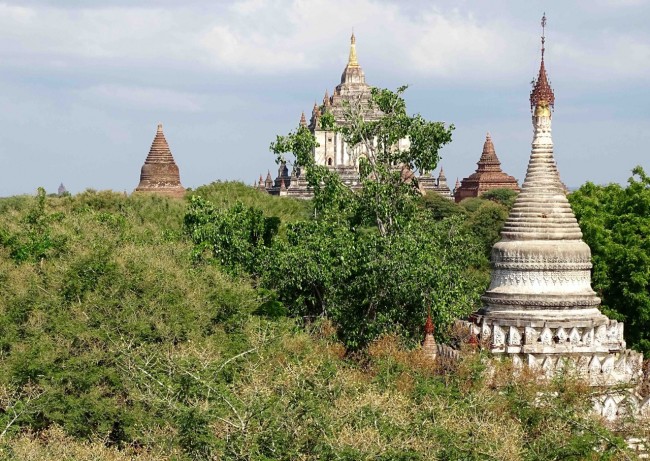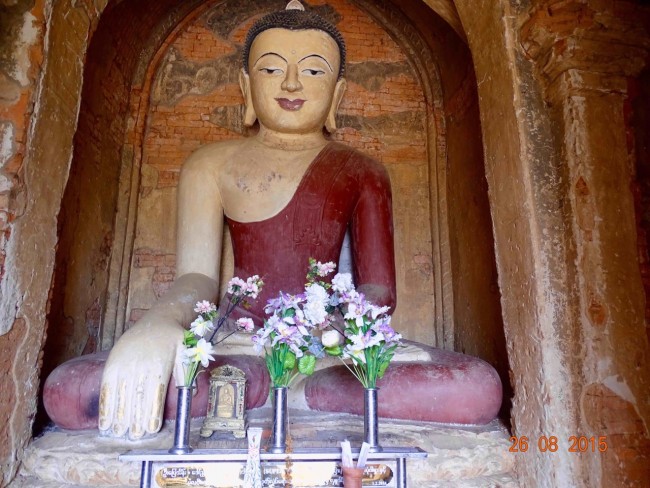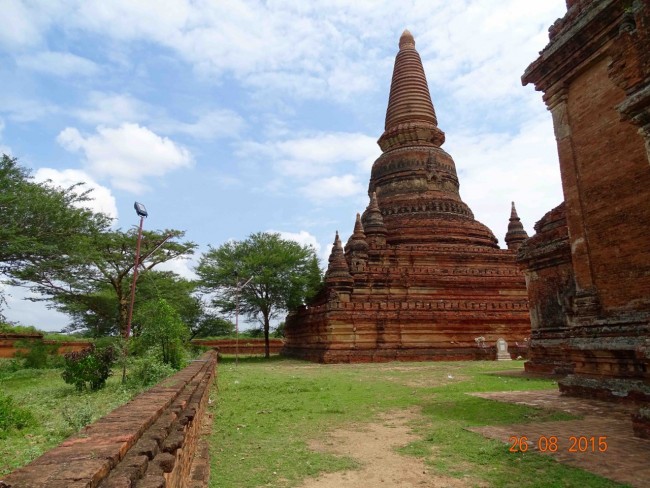A Quick Overview of Bagan
 Bagan was the capitol of Burma from 850 to 1300. Along with Ayutthaya which I discussed in an earlier blog, Bagan is one of the most inspiring places on the tourist circuit in Southeast Asia. Readers who plan to visit this magnificent place should buy the book Guide to Myanmar (Burma): The Temples of Bagan by David and Jennifer Raezer. This book borders on the scholarly but is completely accessible to serious tourists. It is available as an eBook through Amazon.
Bagan was the capitol of Burma from 850 to 1300. Along with Ayutthaya which I discussed in an earlier blog, Bagan is one of the most inspiring places on the tourist circuit in Southeast Asia. Readers who plan to visit this magnificent place should buy the book Guide to Myanmar (Burma): The Temples of Bagan by David and Jennifer Raezer. This book borders on the scholarly but is completely accessible to serious tourists. It is available as an eBook through Amazon.
700 years ago there were some 13,000 temples, pagodas, and monasteries scattered over 50 sq km in Bagan. Today there are only about 2,200 left. Kublia Kahn’s conquest of Thaton in 1057 led to the destruction of thousands of these temples.
The stupas and temples I visited varied considerably. Some were in excellent condition and others were falling apart. Some were only stupas (you could not go inside) and others were temples that welcomed visitors to stroll through their corridors. Some were only 1 storey tall and others were 2 stories. Some were quite ornate and others were simple. No two buildings were the same, however. Visitors could spend a week visiting dozens of temples and enjoy something truly new at each site.
Unlike temples in other parts of Southeast Asia, there is very little stone near Bagan. As a result, all the constructions were built of bricks and mortar and then covered with stucco. The stucco made the buildings look like they were constructed of stone.
It was quite common to decorate the temples with both paintings and sculptures. The sculptures were painted in their day but the paint has deteriorated over the centuries. All the temples had at least one Buddha; most of them had dozens if not hundreds of Buddhas. The central shrines have four Buddhas on the four walls that depict the four great events in the Buddha’s life: birth, enlightenment, first sermon, and death.
From the pictures, you can see that the temples have stair step pyramids of terraces. The stupa superstructure rests on top of these terraces. The early temples have small windows with screens that admit very little light and give the interior a cave-like appearance; the later temples are brighter because they have no screens on the windows.
The Renovation of Bagan
Bagan has inevitably deteriorated over time. The Mongols under Kublai Kahn destroyed much of Bagan in the 13th century. The archaeological site was hit with earthquakes in the 19th and 20th centuries; the quake in 1975 registered 6.2 on the Richter scale. The military government in Myanmar during the last 50 years has engaged in restorative work that UNESCO has described as “speculative.” As a result, UNESCO has not awarded the site the honorific of “World Heritage Site.” Then in 1990 the government forcibly relocated villagers out of Old Bagan.
Notwithstanding these problems, Bagan is still one of the most awe inspiring places I’ve seen – and I’ve seen dozens of the most memorable places on earth.
My Personal Experience in Bagan
I arrived at the Bagan bus terminal at 4:30 in the morning. That, by itself, did not bother me because I am accustomed to arriving in new places at odd times of the day. What I found disturbing, though, was that the bus station was closed and there were no lights to be seen anywhere. The military government, in its wisdom, built the bus station some 10 km away from any settlement because it planned for residential and commercial developments to grow from the currently populated areas out to the bus station over the coming few decades. It was stunningly bizarre to be dropped literally “in the middle of nowhere” and be told that I had arrived! At first I thought I was going to go through a “shake down;” I thought I would be charged more to be driven to the real Bagan. That was not the case at all. I felt totally lost.
Fortunately, there was a taxi driver (with no taxi sign on top of his car) who offered to drive me to a guesthouse. He told me it was a long way and he would charge me $10 Canadian. I had no idea whether to trust the guy or not – but I didn’t have much choice! I told him I wanted a room for $15 Canadian a night.
As it turned out, he was genuinely helpful. First, the distance from the bus station to the guesthouses was as far as he had said. Then he took me to four different guesthouses until I found one that was both acceptable and affordable. By the time I rented a room, I felt he had earned his keep quite well. But I was still amazed at the mental machinations that drive the minds of the dictators of this country.
Since I was traveling on a budget, I set a price of $15 Canadian for a room. Normally, finding a place at that price in Myanmar is not a challenge. Bagan, however, is no ordinary place in Myanmar – it is one of the top four hottest tourist places in the country. So what I found was little more than adequate. It was clean and safe. The bed was hard and the water was cold. The owners were welcoming and gentle. They opened their doors for me at 5:30 in the morning and didn’t bother with the formalities of registering and paying because they knew I only wanted to sleep – and so did they. When I woke up a few hours later they offered me the use of an electric motorbike for $6 Canadian. This bike proved to be entirely adequate for exploring the temples for the day.
The guide books I read said that I would need to buy a $15 permit to wander around the archaeological zone. I never found a place to buy this permit and no one asked me for it. Further, the guidebook said that climbing on the temples was forbidden because the tourists were causing too much damage. Nevertheless, I never saw any signs prohibiting me from climbing so I scampered up every building and saw everything I wanted to see.
The map that came with my motor scooter was poor quality and proved to be essentially useless. After half an hour I gave up trying to find temples with the help of the map. Instead I simply wandered from temple to temple and enjoyed whatever I found. This proved to be a delightful way to explore Bagan.
If I were to go back – and I am sure I will – I would do things a bit differently. First, I would spend much more time studying the book I recommended at the beginning of this post. I would even take the eBook with me as I explored the various temples and stupas. Second, I would definitely join a guided tour. I’m sure the guide would have highlighted dozens of interesting points that I only realized days later when I revisited the authoritative eBook.
Now that Myanmar has opened its doors to tourists, I’m sure that many more will flock to see the religious buildings in Bagan – and I urge you to go if you have a chance. Block out several days for your visit – not just one day as I did. Don’t try to see everything in one day. Instead, pick only a few sites and explore them thoroughly. Last, explore with a guide. Your visit to Bagan will be a highlight in your life that will rival visits to the Eiffel tower, the Parthenon in Greece, and the pyramids in Eqypt.
Photo Credits
All photos by Jan Wall – All Rights Reserved









Please Share Your Thoughts - Leave A Comment!